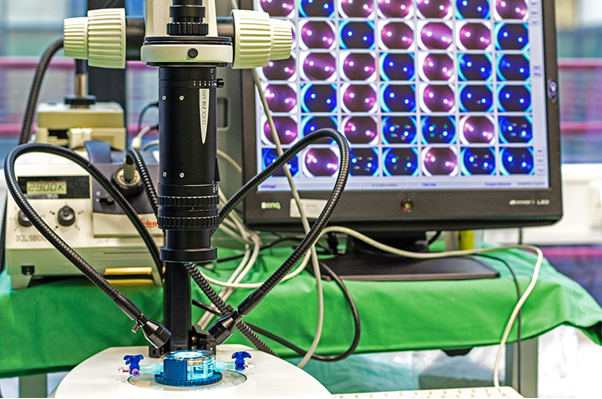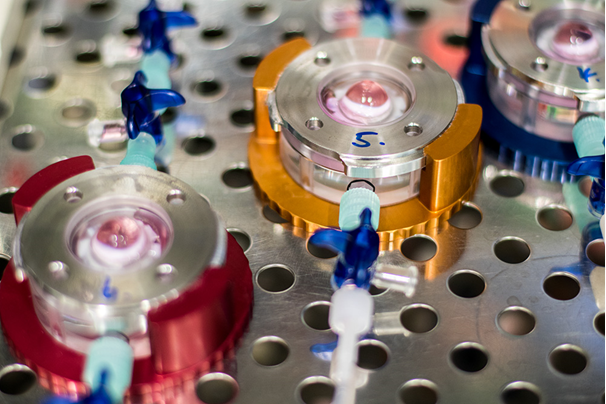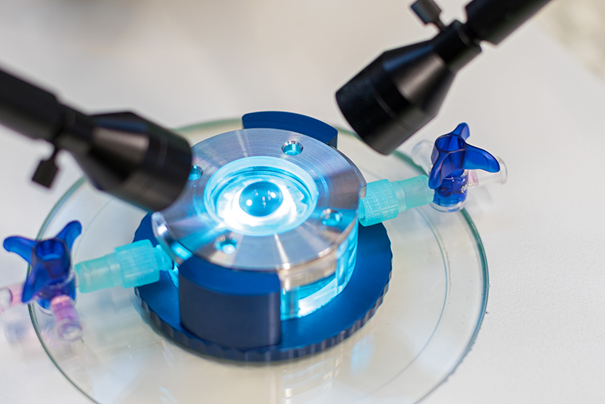Inhalt:
- Test Principle
- Simulation and Therapy of Corneal Inflammation
- Dry Eye Simulation
- Review: Important steps taken so far



Biospotter
The BioSpotter presented here is capable of toxicologically automated use of the EVEIT system.
The three-axis robot is equipped with a dispensing mechanism that allows – similar to an inkjet printer – to place up to five different substances in the nanolitre range on the corneal surface in a location-precise, volume-calibrated and rapid manner.
A stroboscopic calibration system is used to precisely set the volume to be applied. An integrated high-resolution camera allows documentation of macroscopic and fluorescein-stainable changes of the corneal surface.
The BioSpotter can repeatedly target positions on the corneal surface with high accuracy.
The total volume to be applied can be applied sequentially to the corneal surface in the form of repeated partial volumes within fractions of a second.
3R-Principle: Replace, Reduce, Refine
ACTO Offers Alternatives to Animal Testing
If you are interested in testing your substances, formulations, or chemicals in the EVEIT system, please feel free to contact us at: info@acto.de
Test Principle
The EVEIT system, in particular, embraces the generally recognized ethical necessity of using alternatives to animal testing.
In 1959, the zoologist William Russel and the microbiologist Rex Burch first formulated the aim of a “humane science” in their book “The Principles of Humane Experimental Technique”. Today it is known as the 3R-Principle, which stands for Replace (animal tests by alternatives), Reduce (the number of test animals), and Refine (alleviate the suffering of test animals by less harmful tests which yield more conclusive results).
Based on the combination of cornea cultivation and imaging techniques, ACTO aims to establish a method which forms an innovative and universal platform for alternative research without animal testing and which enables prescribed studies within the scope of the new EU-Chemical Regulation (REACH) and the EU-Directive on the Evaluation of Cosmetics and Pharmaceuticals. The EVEIT system replaces animal experiments, delivers better results, and as a whole, can reduce animal experiments.
Since the EVEIT system provides more detailed and more reproducible results than animal experiments, altogether it can reduce and replace animal experiments in ophthalmology and toxicology (DRAIZE test). Eyes of slaughtered rabbits are treated so that they can be cultivated for several weeks. As a result, a testing method is available that makes live animal testing obsolete and yields results that are equally or even more robust than those of animal tests. The essential criterion of this method is the in vitro healing of wounds and chemical injuries.
These corneal tests help researchers to recognize the effect of and tolerance to phosphate-containing eye drops and any possible side effects like calcifications before these eye drops are applied on humans. During these studies, the cornea can be evaluated microscopically and biochemically at any time and longitudinal analyses over time can be taken. This system allows tracing the smallest changes that, in people, may lead to changes of the eye only after years.
By combining the biological EVEIT system with optical coherence tomography (OCT)— introduced by the RWTH Aachen University Institute for Semiconductor Technology (IHT) in a joint research project (cf. 2. BMBF Funding) — another non-invasive analysis method now exists in which even the slightest corneal changes in vitro can be imaged. ACTO e. V. and the IHT have been honored with various prizes for this innovative alternative method to animal testing.
READ MORE:
“Alternative to animal testing: Science award goes to Aachen”
Ex Vivo Eye Irritation Test (EVEIT) means:
- More conclusive results than the unspecific DRAIZE Test
- Standardized exposures
- Reproducible results
- Highest analytical precision
- Predictive results
- Healing and release of inflammatory messengers
The effects on the eye can be subdivided in:
- Pharmaceutical effects on the eye
- Acute changes through toxins, caustic substances, mechanical and physical influences
- Long-term changes after a single- and repeated contact
- Microbiological effects.
Currently animal tests are conducted to examine tolerance to drugs, medical products and chemicals. Even though there are alternative testing methods, they can only detect acute toxicity.
There is no procedure that
- Chronic toxicity
- Repeated application
- Long-term adverse effects, and
- may represent a possible cure.
In the “EVEIT-acute” system, corneal clouding, changes of the surface and of the deeper corneal tissue are detectable through special investigative methods (microscopy, OCT, biochemistry and histology). Long-term changes after such a single contact with a caustic substance and especially the question whether the tissue can be regenerated can only be evaluated when the cornea is kept vital.
In the “EVEIT long-term” system, the cornea is kept alive for 20 days. Here the cornea is nourished with a nutrient medium and is kept moist in a special chamber that mimics the eye. Under these conditions, it can be seen after a single contact but also after multiple contacts with substances, whether the cornea completely heals or whether only the defect heals or no corneal healing takes place.
The question arises of how a cornea reacts after repeated exposure to a substance, e.g., eye drops or cosmetics, which are typical cases in point. Yet after a single exposure to a substance, not all conclusions can be drawn which would be relevant to the exposed person or patient.
In the EVEIT system, however, up to 100 applications of a substance per day can be placed on the cornea for several days in succession. This would be impossible in tests on live animals or even on volunteers. Thus, the EVEIT system enables presenting the temporally compressed reaction to chronic irritations.
The EVEIT multi-local system allows the miniaturized study of chronic and acute risk of chemical substances on one single cornea at various sites of the eye surface. In this way, several tests can be grouped together on one eye. This offers the unique opportunity to test a reference substance as well as a variety of substances or different concentrations of one substance in just one batch on the eye. With this approach, large test series can be condensed and internally referenced. The existing individuality of such a corneal explant simultaneously becomes a reference, and comparisons of the severity of an ocular injury can be systematically delineated in a single corneal section.
This both simplifies and accelerates the testing procedure.
Possible tests in the EVEIT system are: multi-local exposures, eye-drop applications, applications of low-dosed or high-dosed recurring chemical substances, liquids, gases but also particles.
READ MORE
Examples of the effects cited here: EVEIT-fundamental publication
Applied Methods
Freshly explanted eyes of dead rabbits from a rabbit slaughterhouse are used for all the planned and conducted experiments in the EVEIT system.
For the EVEIT-acute test, the freshly explanted rabbit eyes are fixed in a holder and are then applied with the corresponding chemical substance to be tested. Then the eye and its reaction to the chemical substance are carefully observed by means of microscopy and optical coherence tomography.
In the EVEIT-long-term test, the corneas are prepared out of the freshly explanted eyes and are transferred to an artificial eye chamber where the eyes are nourished and microscopically monitored. After 24 hours, the state of the cornea is examined based on biochemical measurement values, the testing of clarity, stability of the epithelium (outer layer) as well as on the functionality of the endothelium (inner layer). Only upon fulfilling these criteria — which allow drawing clear conclusions about the cornea’s vitality — can the corneas be subjected to special tests in an incubator for 3 to 20 days.
During this study, the cornea can be repeatedly evaluated microscopically, and longitudinal analyses over this period can be performed via OCT. The EVEIT system allows tracing the slightest changes that may lead to changes in the human eye only after years. The possibility to conduct many applications within a short time leads to a kind of fast-motion production of effects on the cornea.
We can prove these effects on hand of many experiments and publications. Currently, the project is being prepared for the validation of the replacement of animal tests at the European Centre for the Validation of Alternative Methods (ECVAM).
Corneal Inflammation
At present, ACTO e.V. is further developing the EVEIT system to show that an induced corneal inflammation can be healed.
Simulation of the Dry Eye
ACTO is also further developing the EVEIT system to enable a simulation of the “Dry Eye Syndrome” so that the same aforementioned experiments can be conducted under these conditions.
Review:
To date, the Important Projects in the Development of the EVEIT System
The following two projects have relevantly contributed to the development of the EVEIT system as an alternative method to animal testing:
BMBF-Förderung
Das Bundesministerium für Bildung und Forschung (BMBF) förderte das Projekt REACT – “Rating Eye exposure by an Advanced self-healing Culture Test” in den Jahren 2010 und 2011. Die tierversuchsfreie Testung von Chemikalien am Auge wurde in diesem Projekt weiterentwickelt. Der in den letzten 10 Jahren gemeinsam mit der Universitätsaugenklinik an der RWTH Aachen entwickelte und publizierte Laborprototyp des Ex Vivo Eye Irritation Tests (EVEIT) sollte innerhalb des Projektes mit kompetenten Partnern zu einem industriell anwendbaren und behördlich anerkannten Verfahren weiterentwickelt werden.
Das Institut für Halbleitertechnik an der RWTH Aachen (IHT) steuerte diesem Projekt ein spezielles optisches Verfahren bei, die Optische Kohärenztomographie (OCT). Mit diesem Messverfahren ist eine objektive Dokumentation und Quantifizierung der Auswirkung von Chemikalien auf die Hornhaut erstmals möglich. Damit wird die subjektive Bewertung von Tieraugen durch objektive Laborparameter ersetzt.
Mit der Innolabtec GmbH befand sich ein Partner im Projekt, der sich exzellent mit Steuerung, Automatisierung und Roboterentwicklung für labortechnische Prozesse auskennt. Damit können die bisher im Labor konzipierten Einzelkomponenten des EVEIT in einen technisch ausgewogenen und ablaufsicheren Prozess überführt werden.
Die Fördergelder in Höhe von etwa 500.000 Euro haben in einer Serie von wiederholten Experimenten an 32 Referenzsubstanzen, welche von einem Beirat aus Industrie, ECVAM, Bundesanstalt für Risikobewertung (BfR) und Forschungseinrichtungen bestimmt wurden, neue Ergebnisse zur Reaktion innerhalb des Testsystems erbracht. Insgesamt hat das Testsystem eine hohe Voraussagesicherheit in der Beurteilung von Chemikalien in ihrer Wirkung auf das Auge. Die Einstufung in Kategorie I, II und III nach dem Global armonisierten System zur Einstufung und Kennzeichnung von Chemikalien (GHS, englisch: Globally Harmonized System of Classifikation) wurde in 27 von 32 Substanzen richtig vorhergesagt, in 5 Fällen war der Test noch unterprädiktiv.
Im Projekt konnte die Entwicklung vereinfachter Präparations- und Analyseverfahren im EVEIT Prüfstand vorangetrieben werden.
Untersuchung kosmetischer Produkte (Colipa)
Ex-vivo-Versuche für Kosmetika
Tierversuchsfreie Experimente sollen Kosmetika Tests am lebenden Tier ablösen. Colipa, der Dachverband der europäischen Kosmetikhersteller (Cosmetic, Toiletry and Perfumery Association) lässt vor dem Hintergrund des 2009 greifenden Tierversuchsverbotes in der EU durch Spitzenwissenschaftler Alternativmethoden erforschen.
Das Colipa-Projekt, das von ACTO e. V. in Kooperation mit der Uniklinik RWTH Aachen verfolgt wurde, ist ein Schlüsselprojekt für die gesamte Verätzungsforschung. ACTO konnte im Rahmen dieses Projektes ein neues System mit isolierten Kaninchenaugen entwickeln, welches Heilung, pathologische Heilung und die Reaktion des Auges auf wiederholte Anwendung von Substanzen nachweisen kann. Damit kann in naher Zukunft der für das lebende Tier schmerzhafte DRAIZE-Test abgelöst werden. Die für die Tests eingesetzten Hornhäute stammen von Schlachttieren, die nicht eigens zu diesem Zweck getötet werden.
Dieses System mündet in einer stark weiterentwickelten Version im Ex Vivo Eye Irritation Test (EVEIT):
- Im bisherigen Verlauf der Tests ist nachgewiesen worden, dass der Heilungsprozess des Hornhautepithels als kritischer Faktor bei Augenreizungen messbar ist.
- Monitoring von Glukose, Laktat und pH-Wert geben verlässliche Gewissheit über das Überleben der Hornhäute im Kultursystem.
- Die Menge der Entzündungsbotenstoffe konnte in Proportion zu den Konzentrationen von Reizstoffen gesetzt werden.
- Die Hornhaut überlebte auch wiederholte Expositionen ex vivo in der Kulturkammer.
- Die Heilung des Hornhautepithels ist eine entscheidende Größe in der Beurteilung der Toxizität von neuen Substanzen.
ACTO e.V. ist davon überzeugt, dass die Experimente an Kaninchen-Hornhäuten im Kultursystem, möglicherweise kombiniert mit der Array-Technik an menschlichen Hornhäuten, die sich nicht für die Transplantation eignen, aber für die Forschung zur Verfügung stehen, zu einem System führen werden, das den Draize-Test ersetzen kann, indem es Vorhersagen über den Verlauf von Schädigungen des Auges bei Reizungen und Verätzungen durch chemische Substanzen erlaubt.
